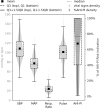Use of a continuous single lead electrocardiogram analytic to predict patient deterioration requiring rapid response team activation
- PMID: 39446712
- PMCID: PMC11500862
- DOI: 10.1371/journal.pdig.0000465
Use of a continuous single lead electrocardiogram analytic to predict patient deterioration requiring rapid response team activation
Abstract
Identifying the onset of patient deterioration is challenging despite the potential to respond to patients earlier with better vital sign monitoring and rapid response team (RRT) activation. In this study an ECG based software as a medical device, the Analytic for Hemodynamic Instability Predictive Index (AHI-PI), was compared to the vital signs of heart rate, blood pressure, and respiratory rate, evaluating how early it indicated risk before an RRT activation. A higher proportion of the events had risk indication by AHI-PI (92.71%) than by vital signs (41.67%). AHI-PI indicated risk early, with an average of over a day before RRT events. In events whose risks were indicated by both AHI-PI and vital signs, AHI-PI demonstrated earlier recognition of deterioration compared to vital signs. A case-control study showed that situations requiring RRTs were more likely to have AHI-PI risk indication than those that did not. The study derived several insights in support of AHI-PI's efficacy as a clinical decision support system. The findings demonstrated AHI-PI's potential to serve as a reliable predictor of future RRT events. It could potentially help clinicians recognize early clinical deterioration and respond to those unnoticed by vital signs, thereby helping clinicians improve clinical outcomes.
Copyright: © 2024 Lee et al. This is an open access article distributed under the terms of the Creative Commons Attribution License, which permits unrestricted use, distribution, and reproduction in any medium, provided the original author and source are credited.
Conflict of interest statement
Bryce Benson and Ashwin Belle are currently employed by Fifth Eye Inc. Sooin Lee was previously employed by Fifth Eye Inc. Bryce Benson, Ashwin Belle, and Kevin Ward have patents and equity interest in Fifth Eye Inc. The remaining authors declare no competing interests exist.
Figures








Similar articles
-
Prediction of episode of hemodynamic instability using an electrocardiogram based analytic: a retrospective cohort study.BMC Anesthesiol. 2023 Sep 22;23(1):324. doi: 10.1186/s12871-023-02283-x. BMC Anesthesiol. 2023. PMID: 37737164 Free PMC article.
-
Detection of Hemodynamic Status Using an Analytic Based on an Electrocardiogram Lead Waveform.Crit Care Explor. 2022 May 17;4(5):e0693. doi: 10.1097/CCE.0000000000000693. eCollection 2022 May. Crit Care Explor. 2022. PMID: 35620767 Free PMC article.
-
Vital Signs Predict Rapid-Response Team Activation Within Twelve Hours of Emergency Department Admission.West J Emerg Med. 2016 May;17(3):324-30. doi: 10.5811/westjem.2016.2.28501. Epub 2016 Apr 26. West J Emerg Med. 2016. PMID: 27330665 Free PMC article.
-
Diurnal variation in the performance of rapid response systems: the role of critical care services-a review article.J Intensive Care. 2016 Feb 24;4:15. doi: 10.1186/s40560-016-0136-5. eCollection 2016. J Intensive Care. 2016. PMID: 26913199 Free PMC article. Review.
-
The impact of wearable continuous vital sign monitoring on deterioration detection and clinical outcomes in hospitalised patients: a systematic review and meta-analysis.Crit Care. 2021 Sep 28;25(1):351. doi: 10.1186/s13054-021-03766-4. Crit Care. 2021. PMID: 34583742 Free PMC article.
Cited by
-
Artificial intelligence for the prediction of postoperative complications in the critically ill.Crit Care Sci. 2025 Jun 20;37:e20250025. doi: 10.62675/2965-2774.20250025. eCollection 2025. Crit Care Sci. 2025. PMID: 40561342 Free PMC article. No abstract available.
References
-
- Haddad LM, Annamaraju P, Toney-Butler TJ. Nursing Shortage. StatPearls. 2023. - PubMed
LinkOut - more resources
Full Text Sources
Research Materials
Miscellaneous
